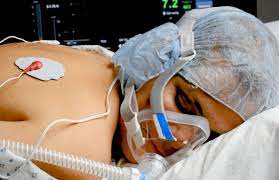 Prone ventilation, sometimes called prone positioning, refers to mechanical ventilation with the patient lying face-down (prone).
Prone ventilation, sometimes called prone positioning, refers to mechanical ventilation with the patient lying face-down (prone).
It improves oxygenation in most patients with acute respiratory distress syndrome (ARDS) and reduces mortality.
Prone ventilation improves lung mechanics, improve oxygenation, and increased survival.
The purpose of prone ventilation is to better facilitate lung mechanics to improve ventilation/perfusion ratio mismatches in ARDS.
By redistributing pulmonary blood flow, oxygen levels can be increased from low ventilated areas to higher ventilation.
There is a gravity-dependent increase in pleural pressure when supine compared to prone.
In the prone position, the lungs’ dorsal aspects have less pleural pressure, which alleviates forces trying to collapse the alveoli.
With less pleural pressure, the alveoli can stay open and thus increase surface area for ventilation.
Because there are more alveoli dorsally than ventrally, a prone position allows for more dorsal alveoli to stay open and thus increase the amount of ventilation available to be perfused.
Prone ventilation reduces Ventilator-associated lung injury, redistributes dependent fluid and lead to more homogenous compliance of the lung minimizing the barotrauma that usually occurs from more heterogeneous lungs and the repeated opening and closing of alveoli.
Prone ventilation reduces over distention of nondependent lung regions, and less cyclical airspace opening and closing in dependent regions during prone position, perhaps reducing ventilator induced lung injury.
Prone ventilation is associated with a reduction in IL-6, a marker of systemic inflammation, in the prone ventilation group compared to the supine ventilation.
Prone ventilation is attributed to a decrease in barotrauma and a rapid decrease in the need for high FiO2, reducing the number of reactive oxygen species contributing to ongoing inflammation in the lung.
Studies suggest that patients only benefit from prone ventilation when they are in a prone position for longer than 12 hours a day.
Among patients with ARDS, prone ventilation provided for at least 16 hours a day significantly reduces 90 day mortality.
The main benefit of prone positioning is less ventilator induced lung injury, and the routine prone positioning use is strongly recommended in current clinical practice guidelines.
During the COVID-19 pandemic, awake high flow nasal cannula in the prone position, awake proning, was utilized to keep patients from being intubated: analysis showed that the number needed to treat and keep people off the ventilator was 6.
A Cochrane meta-analysis found low certainty evidence of benefit in oxygen saturation with prone positioning of mechanically ventilated preterm infants with ARDS but increased risk of SIDS.
Contraindications to prone ventilation:
Hemodynamic instability.
unstable fractures or polytrauma patients with unstable fracture spine
tracheostomy
chest tubes
obesity
pregnancy
Elevated intracranial pressure
cardiac surgery
massive hemoptysis
aspiration pneumonia
Complications:
Complications occur because of the position and the effect of gravity on the body.
Increased time that staff members need to monitor and help patients in this disabling position.
Increased endotracheal tube displacement and even accidental extubation, loss of vascular lines, pressure sores, brachial plexopathy, enteral feeding intolerance, facial edema, and injury.
Among patients with severe ARDS, supported by venovenous extra corporeal membrane oxygenation, prone positioning, compared with supine positioning, did not significantly reduced time to successful weaning of extracorporeal membrane oxygenation (PRONECMO, investigators).
